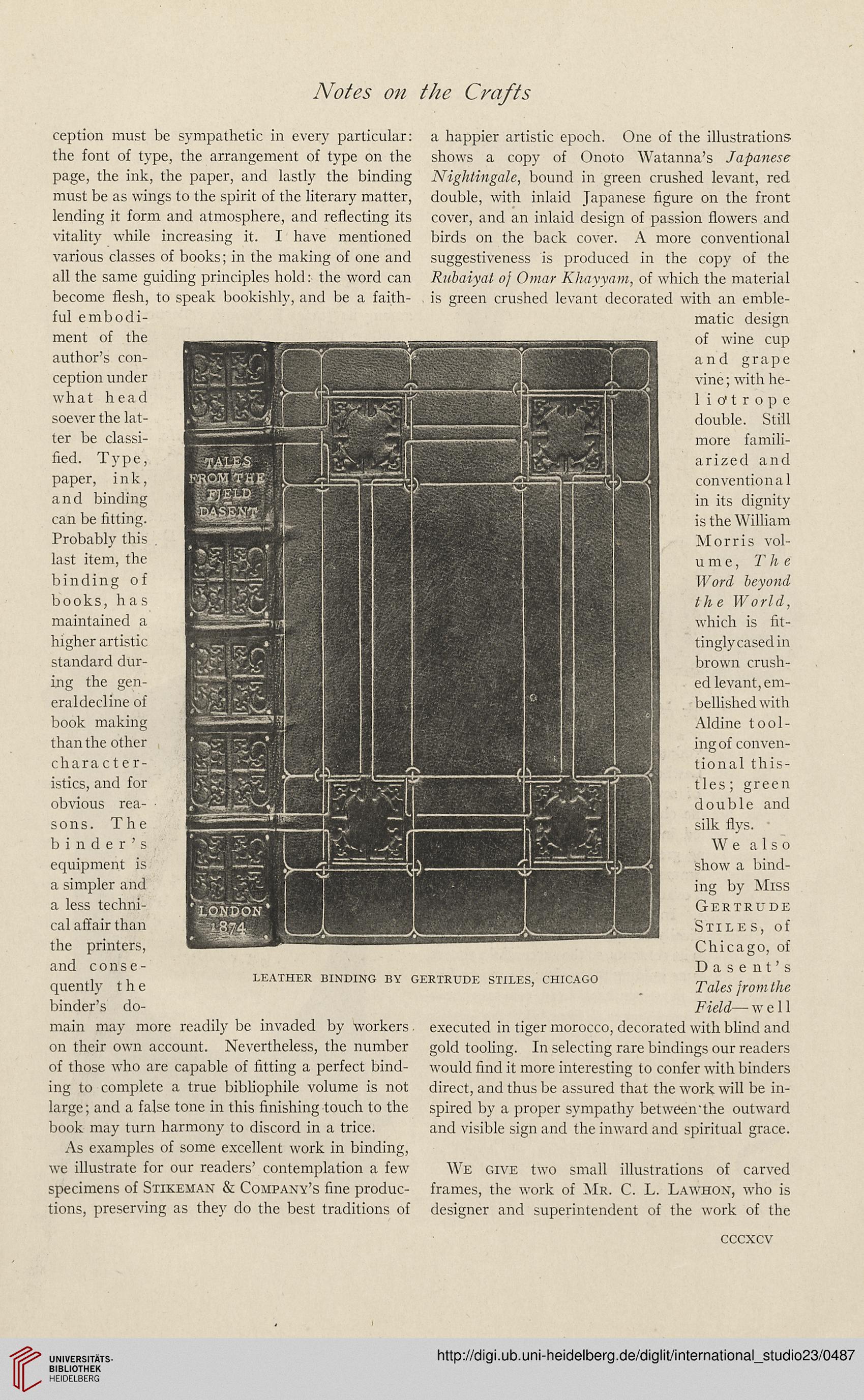Notes on the Crafts
ception must be sympathetic in every particular:
the font of type, the arrangement of type on the
page, the ink, the paper, and lastly the binding
must be as wings to the spirit of the literary matter,
lending it form and atmosphere, and reflecting its
vitality while increasing it. I have mentioned
various classes of books; in the making of one and
all the same guiding principles hold: the word can
become flesh, to speak bookishly, and be a faith-
ful embodi-
ment of the
the printers,
and conse-
quently the
binder’s do-
main may more readily be invaded by workers
on their own account. Nevertheless, the number
of those who are capable of fitting a perfect bind-
ing to complete a true bibliophile volume is not
large; and a false tone in this finishing touch to the
book may turn harmony to discord in a trice.
As examples of some excellent work in binding,
we illustrate for our readers’ contemplation a few
specimens of Stikeman & Company’s fine produc-
tions, preserving as they do the best traditions of
LEATHER BINDING BY GERTRUDE STILES, CHICAGO
a happier artistic epoch. One of the illustrations
shows a copy of Onoto Watanna’s Japanese
Nightingale, bound in green crushed levant, red
double, with inlaid Japanese figure on the front
cover, and an inlaid design of passion flowers and
birds on the back cover. A more conventional
suggestiveness is produced in the copy of the
Rubaiyat oj Omar Khayyam, of which the material
is green crushed levant decorated with an emble-
matic design
of wine cup
and grape
vine; with he-
1 i o' t r o p e
double. Still
more famili-
arized and
conventional
in its dignity
is the William
Morris vol-
ume, The
Word beyond
the World,
which is fit-
tingly cased in
brown crush-
ed levant, em-
bellished with
Aldine tool-
ing of conven-
tional this-
tles; green
double and
silk flys.
We also
show a bind-
ing by Miss
Gertrude
Stiles, of
Chicago, of
Dasent’s
Tales from the
Field—well
executed in tiger morocco, decorated with blind and
gold tooling. In selecting rare bindings our readers
would find it more interesting to confer with binders
direct, and thus be assured that the work will be in-
spired by a proper sympathy between'the outward
and visible sign and the inward and spiritual grace.
We give two small illustrations of carved
frames, the work of Mr. C. L. Lawhon, who is
designer and superintendent of the work of the
author’s con-
ception under
what head
soever the lat-
ter be classi-
fied. Type,
paper, ink,
and binding
can be fitting.
Probably this
last item, the
binding of
books, has
maintained a
higher artistic
standard dur-
ing the gen-
eraldecline of
book making
than the other
character-
istics, and for
obvious rea-
sons. The
binder’s
equipment is
a simpler and
a less techni-
cal affair than
cccxcv
ception must be sympathetic in every particular:
the font of type, the arrangement of type on the
page, the ink, the paper, and lastly the binding
must be as wings to the spirit of the literary matter,
lending it form and atmosphere, and reflecting its
vitality while increasing it. I have mentioned
various classes of books; in the making of one and
all the same guiding principles hold: the word can
become flesh, to speak bookishly, and be a faith-
ful embodi-
ment of the
the printers,
and conse-
quently the
binder’s do-
main may more readily be invaded by workers
on their own account. Nevertheless, the number
of those who are capable of fitting a perfect bind-
ing to complete a true bibliophile volume is not
large; and a false tone in this finishing touch to the
book may turn harmony to discord in a trice.
As examples of some excellent work in binding,
we illustrate for our readers’ contemplation a few
specimens of Stikeman & Company’s fine produc-
tions, preserving as they do the best traditions of
LEATHER BINDING BY GERTRUDE STILES, CHICAGO
a happier artistic epoch. One of the illustrations
shows a copy of Onoto Watanna’s Japanese
Nightingale, bound in green crushed levant, red
double, with inlaid Japanese figure on the front
cover, and an inlaid design of passion flowers and
birds on the back cover. A more conventional
suggestiveness is produced in the copy of the
Rubaiyat oj Omar Khayyam, of which the material
is green crushed levant decorated with an emble-
matic design
of wine cup
and grape
vine; with he-
1 i o' t r o p e
double. Still
more famili-
arized and
conventional
in its dignity
is the William
Morris vol-
ume, The
Word beyond
the World,
which is fit-
tingly cased in
brown crush-
ed levant, em-
bellished with
Aldine tool-
ing of conven-
tional this-
tles; green
double and
silk flys.
We also
show a bind-
ing by Miss
Gertrude
Stiles, of
Chicago, of
Dasent’s
Tales from the
Field—well
executed in tiger morocco, decorated with blind and
gold tooling. In selecting rare bindings our readers
would find it more interesting to confer with binders
direct, and thus be assured that the work will be in-
spired by a proper sympathy between'the outward
and visible sign and the inward and spiritual grace.
We give two small illustrations of carved
frames, the work of Mr. C. L. Lawhon, who is
designer and superintendent of the work of the
author’s con-
ception under
what head
soever the lat-
ter be classi-
fied. Type,
paper, ink,
and binding
can be fitting.
Probably this
last item, the
binding of
books, has
maintained a
higher artistic
standard dur-
ing the gen-
eraldecline of
book making
than the other
character-
istics, and for
obvious rea-
sons. The
binder’s
equipment is
a simpler and
a less techni-
cal affair than
cccxcv




